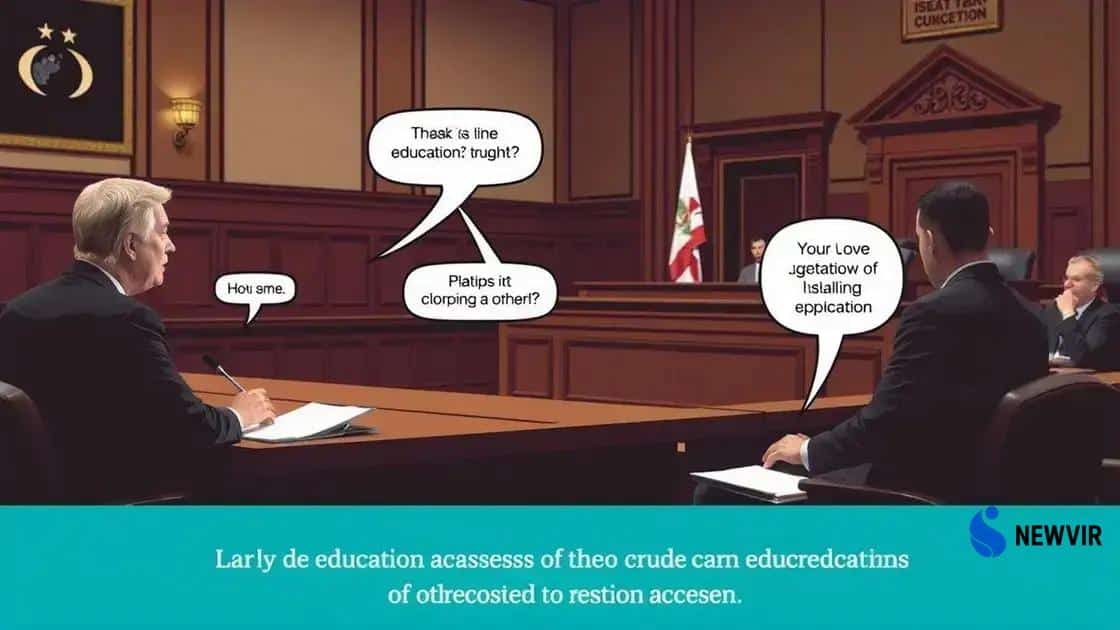Legal disputes surrounding access to education: what you need to know

Legal disputes surrounding access to education involve significant cases and advocacy efforts that shape policies, promote equity, and address the rights of students and communities, ensuring fair educational opportunities for all.
Legal disputes surrounding access to education raise important questions about equality and rights. Ever wondered how these disputes affect students’ futures? Let’s dive into this complex issue.
Overview of legal disputes in education
Understanding legal disputes in education is crucial for grasping how our educational systems function. These conflicts often arise over issues such as access, equity, and funding, affecting students and schools alike. They can involve parents, educators, and local governments trying to navigate the complex landscape of educational rights.
Common Reasons for Legal Disputes
Several critical issues often lead to disputes in education. They highlight the various challenges stakeholders face in ensuring that every student receives a fair opportunity. Some common reasons include:
- Discrimination based on race, gender, or disability.
- Funding inequities between school districts.
- Individualized Education Programs (IEPs) for students with special needs.
- Disputes over curriculum standards and content.
Each of these reasons reflects a broader concern about access and quality in education. For instance, funding inequities can lead to significant differences in resources available to students. Schools in wealthier districts often have more facilities and programs than those in less affluent areas.
Impacts of Legal Disputes
The consequences of legal disputes in education reach far beyond the courtroom. They can influence policies and practices adopted in schools. For example, a landmark case could set a precedent, leading to changes in how schools manage their resources and address student needs. As legal rulings unfold, it’s essential to consider their implications for educators, students, and parents.
Moreover, these disputes often consume valuable resources, diverting attention from teaching and learning. Teachers might find themselves navigating a complex legal landscape instead of focusing on their students. In the end, understanding these conflicts helps frame the ongoing conversation about how to improve our education system for everyone.
Key cases impacting access
Several key cases have played a pivotal role in shaping access to education in the United States. These cases address significant issues, providing insight into how legal decisions affect schools and students. Understanding these cases helps to comprehend the broader implications of legal disputes in education.
Brown v. Board of Education
The landmark case of Brown v. Board of Education (1954) is a cornerstone of the fight against segregation in schools. This ruling declared that separate educational facilities are inherently unequal, ultimately leading to the desegregation of public schools across the nation. This decision paved the way for more equitable access to education for all students.
Individuals with Disabilities Education Act (IDEA)
The Individuals with Disabilities Education Act ensures that students with disabilities receive a free and appropriate public education. Legal challenges related to IDEA have highlighted the need for schools to accommodate all students effectively. These cases often emphasize individualized education programs (IEPs), which tailor education to meet each student’s unique needs.
- This act promotes inclusion by requiring special education services in mainstream schools.
- It mandates that schools develop IEPs based on individual student assessments.
- Legal disputes often focus on whether schools are complying with these requirements.
Through these legal frameworks, students with disabilities gain improved access to education, ensuring their rights are respected.
Ferguson v. City of Charleston
The case of Ferguson v. City of Charleston (2001) addressed the issue of maternity policies in schools. In this decision, the court ruled that a hospital’s policy discriminated against pregnant students by encouraging them to leave school. The court’s ruling emphasized the importance of providing equal educational opportunities for all students, regardless of their circumstances.
Examining these key cases shows how the legal system has gradually worked to enhance access to education. These decisions laid the groundwork for more inclusive practices and challenge existing inequalities.
How legal rulings shape educational policy

Legal rulings significantly influence educational policy by establishing precedents that schools and districts must follow. When courts make decisions regarding education, they can direct how policies are created or modified to ensure compliance with the law. For example, a ruling can mandate changes in curriculum, funding practices, or even hiring policies.
The Role of the Courts in Education
Courts serve as a crucial check on educational institutions, helping to enforce students’ rights. When disputes arise, legal decisions can reshape existing policies. For instance, if a court finds that a school is not adequately serving students with disabilities, it can lead to a complete overhaul of the school’s approach to special education.
- Enforcement of rights: Courts often ensure that students’ rights are protected under federal and state laws.
- Impact on funding: Legal decisions can influence how funds are allocated, potentially leading to more equitable distribution across districts.
- Changes in policy: Court rulings can result in necessary updates to school policies to remain compliant with legal standards.
Such rulings not only address immediate issues but also serve as a guide for future actions, creating long-term effects on educational practices.
Impact on Educational Equity
One of the most profound impacts legal rulings have is on educational equity. By addressing disparities in education, courts can help level the playing field, ensuring fair access for all students. For example, cases that challenge funding inequities push policymakers to consider how resources are distributed among different schools and districts.
Legal rulings often highlight the importance of creating inclusive environments that cater to diverse student populations. This focus can lead to policy reforms aimed at better supporting marginalized groups. Schools may be required to implement programs that ensure all students have access to the same quality of education.
Overall, the interplay between legal rulings and educational policy underscores how law can serve as a powerful tool in promoting a more just and equitable education system.
The role of advocacy groups
Advocacy groups play a critical role in shaping educational policy by addressing issues related to access and equity in education. These organizations work tirelessly to represent the interests of students, parents, and communities, raising awareness of the challenges faced in the educational system.
Mobilizing Community Support
One of the key functions of advocacy groups is to mobilize community support for educational initiatives. By organizing events, campaigns, and outreach programs, they educate families about their rights and the resources available to them. Engaging communities fosters a sense of empowerment, encouraging individuals to take action on important issues.
- Community Engagement: They facilitate meetings and forums to discuss educational needs.
- Protest and Awareness Campaigns: Advocacy groups organize rallies to call attention to pressing issues.
- Information Dissemination: They provide resources and guides to help families navigate the educational landscape.
These activities are vital in highlighting the significance of educational equity and affecting change at the local and national levels.
Influencing Policy Changes
Advocacy groups also play a significant role in influencing policy changes that affect education. By engaging in lobbying efforts, they work to persuade lawmakers to pass legislation that addresses systemic issues. They utilize data, research, and personal testimonies to make compelling cases for reform.
Effective advocacy can lead to the implementation of policies that promote fairness in education. For example, advocacy for funding reforms ensures that schools in low-income areas receive the necessary resources to operate effectively. This push for enhanced funding directly contributes to improving student outcomes.
Furthermore, these groups often collaborate with educational institutions and government agencies, fostering partnerships that yield positive results. Their efforts not only advocate for students currently in the system but also create pathways for future generations to access quality education.
Future trends in education law
The landscape of education law is constantly evolving, responding to societal changes and emerging needs. As we look to the future, several trends are shaping how education laws may develop and influence schools and students.
Increased Focus on Equity
One significant trend is the increasing focus on equity in education. Advocacy for students from diverse backgrounds is becoming more prominent. This shift is driving policy changes to ensure that all students have equal access to high-quality education, regardless of their circumstances.
- Equitable funding: Laws are being proposed to address funding discrepancies between wealthy and under-resourced schools.
- Inclusion policies: More attention is being placed on creating inclusive environments for students with disabilities.
- Support for marginalized groups: Legislation is being developed to provide additional resources for students from minority backgrounds.
These changes reflect a growing recognition that fair educational opportunities are essential for all students.
Technology and Education Law
Another trend is the integration of technology into education and the legal implications that arise. As schools adopt more digital tools, new laws are required to address issues such as data privacy and cybersecurity. This focus on technology is creating a need for policies that safeguard student information.
Some considerations include:
- Protecting student data: Schools must develop clear policies on how they collect and manage student data.
- Adapting to online learning: Education laws are adapting to account for the growing prevalence of online learning platforms.
- Ensuring accessibility: Laws are emerging to ensure that educational technologies are accessible to all students.
As technology becomes a critical component of education, legal frameworks are evolving to keep pace with these changes.
Changes in Disciplinary Procedures
Future trends in education law also suggest shifts in how disciplinary procedures are handled within schools. There’s a growing emphasis on restorative justice practices rather than punitive measures. This approach focuses on repairing harm and improving student behavior through understanding and accountability.
With these changes, schools are beginning to implement:
- Restorative practices: Encouraging dialogue and reconciliation rather than harsh punishments.
- Support systems: Providing support for students facing behavioral issues to address underlying challenges.
- Community involvement: Involving families and community members in the disciplinary process to foster cooperation.
These shifts show a more compassionate approach to discipline, promoting a positive school climate.
FAQ – Questions about Legal Disputes Surrounding Access to Education
What role do advocacy groups play in education law?
Advocacy groups raise awareness about educational issues, mobilize community support, and influence policy changes to ensure equitable access for all students.
How can legal rulings affect educational policy?
Legal rulings can set precedents that schools must follow, impacting funding, curriculum, and the treatment of students, thereby shaping educational practices.
What are some future trends in education law?
Future trends include a focus on equity in education, the integration of technology and data privacy protections, and changes in disciplinary practices towards restorative justice.
Why is understanding education law important?
Understanding education law helps educators, parents, and students navigate the system, ensuring that rights are upheld and quality education is accessible to all.






